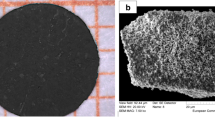Abstract
The ablation interaction between a laser and solid samples, which affects the analytical performance for laser ablation inductively coupled plasma atomic emission spectrometry (LA-ICP-AES), was studied. The emission intensities of elements observed by LA-ICP-AES (LA-ICP-AES element signal intensities) for different solid samples were measured under different laser defocusing conditions with a fixed laser output energy. It was found that the optimum laser defocusing conditions were dependent on the different solid samples with different sample characteristics, and also on the different elements with different elemental characteristics in each solid sample. A low-alloy steel, pellets containing different Fe concentrations (0-100% Fe pellet), and a pond sediment pellet were used as different solid samples. The variations of the LA-ICP-AES Fe signal intensities observed under different laser defocus conditions were completely different between the low-alloy steel and the pond sediment pellet. The changes in the LA-ICP-AES Fe signal intensities for 90 and 100% Fe pellets were similar to that of the low-alloy steel. However, pellets with lower Fe concentrations (less than 70%) showed different trends and the defocusing behavior became closer to that of the pond sediment pellet. The LA-ICP-AES signal intensities of other elements were also evaluated, and were compared for different solid samples and different defocusing behavior. It was observed that the changes in the LA-ICP-AES signal intensities of almost all elements in the pond sediment pellet showed a similar trend to those of Fe for different laser defocus positions; that is, the elemental fractionation for these elements in the pond sediment pellet seemed to be relatively small. On the contrary, it was found that the LA-ICP-AES Si, Ti, and Zr signal intensities for low-alloy steel showed different trends compared to those of other elements, including Fe, under different defocusing conditions; that is, the elemental fractionation observed for the low-alloy steel was larger than that of the pond sediment pellet. From these results, different ablation interactions between the laser and the different solid samples were considered, and attributed to the sample characteristics, such as the matrix, hardness, and conductivity. Elemental fractionation was attempted to be explained by using elemental characteristics, such as the melting point and ionization energy of the elements.
Similar content being viewed by others
References
M. Hemmerlin, D. Somas, C. Dubuisson, F. Loisy, E. Poussel, and J. M. Mermet, Fresenius J. Anal. Chem., 2000, 368, 31.
M. Hemmerlin, J. M. Mermet, M. Bertucci, and P. Zydowicz, Spectrochim. Acta Part B, 1997, 51, 421.
V. Kanicky, V. Otruba, and J. M. Mermet, Spectrochim. Acta Part B, 2000, 55, 575.
P. Musil, V. Otruba, V. Kanicky, and J. M. Mermet, Spectrochim. Acta Part B, 2000, 55, 1747.
M. Ohata, Y. Iwasaki, N. Furuta, and I. B. Brenner, Spectrochim. Acta, Part B, 2002, 57, 1713.
S. H. Jeong, O. V. Borisov, J. H. Yoo, X. L. Mao, and R. E. Russo, Anal. Chem., 1999, 71, 5123.
M. M. Heino, S. Rauch, G. M. Morrison, and O. F. X. Donard, Anal. Chim. Acta, 2001, 436, 233.
T. Hirata, J. Anal. At. Spectrom., 2002, 17, 204.
P. H. Chi, F. H. Ko, C. T. Hsu, H. L. Chen, C. K. Yang, Y. C. Sun, and M. H. Yang, J. Anal. At. Spectrom., 2002, 17, 358.
G. Tao, Y. Fujikawa, M. Mitsui, and R. Yamada, J. Anal. At. Spectrom., 2002, 17, 560.
N. H. Bings, J. Anal. At. Spectrom., 2002, 17, 759.
J. Feldmann, A. Kindness, and P. Ek, J. Anal. At. Spectrom., 2002, 17, 813.
A. M. Leach and G. M. Hieftje, J. Anal. At. Spectrom., 2002, 17, 852.
P. R. D. Mason and W. J. Kraan, J. Anal. At. Spectrom., 2002, 17, 858.
T. Prohaska, C. Latkoczy, G. Schultheis, M. T. Nicola, and G. Stingeder, J. Anal. At. Spectrom., 2002, 17, 887.
P. Marshall, O. Heudi, S. Bains, H. N. Freeman, F. A. Shakra, and K. Reardon, Analyst, 2002, 127, 459.
D. Gunther, Anal. Bioanal. Chem., 2002, 372, 31.
R. E. Russo, X. Mao, H. Liu, J. Gonzalez, and S. S. Mao, Talanta, 2002, 57, 425.
J. Koch, I. Feldmann, N. Jakubowski, and K. Niemax, Spectrochim. Acta Part B, 2002, 57, 975.
M. Ohata, H. Yasuda, Y. Namai, and N. Furuta, Anal. Sci., 2002, 18, 1105.
R. E. Russo, X. Mao, and S. S. Mao, Anal. Chem., 2002, 74, 71A.
Z. X. Chen, J. Anal. At. Spectrom., 1999, 14, 1823.
D. R. Lide, “Handbook of Chemistry and Physics”, 79th ed., 1998, CRC Press LLC.
Author information
Authors and Affiliations
Rights and permissions
About this article
Cite this article
Ohata, M., Furuta, N. Laser Defocusing Effects on Laser Ablation Inductively Coupled Plasma-Atomic Emission Spectrometry: Different Ablation Interactions between the Laser and Low-Alloy Steel, Fe Pellets, and a Pond Sediment Pellet. ANAL. SCI. 20, 701–706 (2004). https://doi.org/10.2116/analsci.20.701
Received:
Accepted:
Published:
Issue Date:
DOI: https://doi.org/10.2116/analsci.20.701



